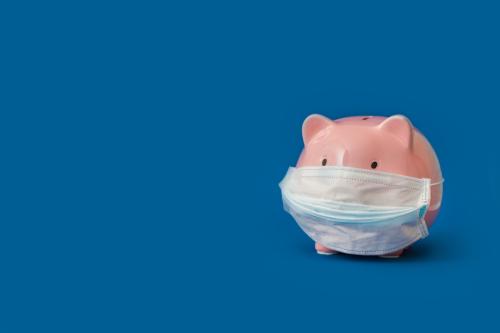This post was updated on February 16, 2021.
One of the points of controversy in Congress over the size and shape of the federal fiscal response to the COVID-19 pandemic has been whether to send aid state and local governments. The latest package approved by Congress provides roughly $125 billion to these governments for education, health, public transit, and highways, but no general aid to states or localities to cover revenue losses. The issue of aid to state and local governments is likely to resurface next year.
State and local governments are a major piece of the U.S. economy, accounting for about 13% of all employment. They typically have balanced budget requirements, which mean that shortfalls in revenues must be offset with spending cuts or tax increases, actions which hurt taxpayers and impede the economic recovery. State and local governments have cut employment by about 7%—or roughly 1.3 million jobs—since the beginning of the pandemic, which some ascribe to dire fiscal conditions. Cutbacks by state and local governments were a significant restraint on the economy in the slow recovery from the Great Recession.
As I discuss below, the revenue losses from the pandemic appear to be much smaller than originally anticipated, and federal aid provided to date is likely to exceed them in the aggregate, at least over the next few years. Of course, state and local governments are facing higher demands on spending as a result of the pandemic and revenue losses in some states are likely to greatly exceed federal aid, so budgets may still be under strain. Nevertheless, the huge fall in employment seems out of proportion with the amount of fiscal stress.
So why has employment declined so much? Social distancing, and all that it entails, is likely a very important factor. But there is also evidence that tight fiscal conditions have led to employment declines in local education, which accounts for roughly 5% of the overall U.S. workforce. Furthermore, state and local governments, having been scarred by the Great Recession, are likely being very cautious about spending given the tremendous uncertainty about the economic outlook, and some states—those particularly reliant on tourism, for instance—are clearly facing very difficult budget conditions. The recently enacted aid, as well as the prospect of widespread vaccination over the next few months, should help spur state and local government spending and strengthen the economic recovery as a result.
How big are the revenue losses likely to be?
As Alan Auerbach, William Gale, Byron Lutz, and I noted in a recent Brookings Papers on Economic Activity (BPEA) paper, this recession is quite different from previous ones. Many of these differences suggest the revenue losses will be smaller than in the usual recession: employment losses have been concentrated to an unusual degree among low-wage workers (who pay less in income taxes); the stock market has risen, not fallen (which drives capital gains tax receipts); and the unprecedented $2 trillion CARES Act fiscal stimulus enacted last spring supported consumption, and hence sales tax revenues, as well as taxable income (in part because unemployment benefits are taxable in most states). On the other hand, consumption patterns have changed dramatically as a result of the pandemic, decimating fees and taxes collected on airport use, gasoline sales, recreational services, mass transit, and the like. On net, however, we concluded that the state and local government revenue losses from the recession would be moderate and far smaller than some had predicted on the basis of the increase in the unemployment rate.
Recent data have suggested that the estimates in our September 2020 paper were likely too large. We relied on Congressional Budget Office (CBO) economic projections that turned out to be too pessimistic, at least so far. For example, CBO had projected that personal consumption in the third quarter of 2020 would be 5.8% below its level in the third quarter of 2019—but the Bureau of Economic Analysis’ (BEA) current estimate is that the decline was only 1.7%. While we have not updated our estimates, a rough back-of-the-envelope calculation suggests that state and local government revenue losses (including losses by public hospitals and higher education institutions) from 2020 to 2022 will likely be on the order of $200 billion to $300 billion—about 3% to 4% below what they would have expected pre-COVID.
These estimates are roughly consistent with the incoming data on tax collections. The most recent Quarterly Summary of State and Local Tax Revenues from the Census Bureau shows that tax revenues for the first three quarters of 2020 are down about 1% relative to the same period of 2019; without the pandemic, revenues would probably have increased about 3%. Data from BEA show a similar decline in state and local own-source revenue (total receipts less aid from the federal government) over this time period. Data collected by the Urban Institute on state tax revenues show total tax collections down 5.3% in the second quarter of this year relative to last year. Accounting for strong growth of tax collections in the first quarter and likely smaller losses in local government revenues (because property taxes, which account for more than 70% of local tax revenues, have held up well during the pandemic) would likely bring the Urban Institute numbers roughly in line with those from the Census Bureau and the BEA.
State and local governments have received about $280 billion in federal aid thus far, and the latest fiscal package contains roughly $120 billion more. Aid thus exceeds my back-of-the-envelope estimate of expected revenue losses over the next three years by about $50 billion. But state and local governments have also faced increased expenses related to the pandemic, particularly with respect to public health—so budgets may still be tight. In addition, there is a huge amount of heterogeneity both across and within states—states that depend heavily on tourism or oil revenue have been hit much harder, transit agencies have seen their revenues collapse, and, as I discuss below, local school districts may be under a great deal of strain even in states that are in decent financial shape as a whole.
How big are pandemic-induced revenue losses compared to those experienced during the Great Recession?
The revenue losses now anticipated for the state and local sector due to the pandemic are much smaller than those states experienced during the Great Recession. As the chart below shows, inflation-adjusted (real) own-source revenues fell about 8% during the Great Recession and stayed below pre-recession levels until the end of 2013.
I estimate that in this recession, real own-source revenues will be 3¼% below the 2019 level in 2020, about equal to the 2019 level in 2021, and exceed it by 2022. Thus the drop in revenues is expected to be much smaller and much less persistent than during the Great Recession.

How has state and local employment changed since the pandemic, and how do these declines compare to those experienced during the Great Recession?
Despite these projections of relatively muted revenues losses, employment by state and local governments has plummeted during the pandemic. The figures below compare employment declines by state and local governments in the current recession with those experienced during the Great Recession. Three things to note:
- The declines in employment this year surpass those experienced during the Great Recession, despite the much smaller revenue losses this year.
- Employment started declining in March—the beginning of the recession—whereas in the Great Recession (and indeed, in most recessions), employment declines in the state and local sector tend to lag the decline in overall economic activity.
- In the Great Recession, state governments increased employment at institutions of higher education, while employment in other parts of state government fell; this recession, the reverse is true. At the local level, employment declines have been somewhat larger in education than in non-education, whereas they were quite similar during the Great Recession.


If the revenue losses are not that large, why has employment changed so much?
The decline in state and local employment appears to result at least in part from the need to socially distance during the pandemic. As schools went virtual in March and April, the need for bus drivers and cafeteria workers fell; declining enrollment in both K-12 and universities also meant that fewer staff were needed. (The V-shaped pattern in local education employment in the figure above reflect this—normally, bus drivers and cafeteria workers are laid off in the summer. In these seasonally-adjusted data, the early layoffs showed up as declines in the spring but increases in the summer.) Similarly, closure of parks and greatly reduced traffics on roads and at airports and ports reduced the need for staff.
Were tight budget conditions also a factor? Using the 2020 projected revenue losses (excluding losses at hospitals and institutions of higher education) and estimated federal aid by state from the BPEA paper allow us to assess the degree to which employment declines are correlated with tight fiscal conditions. As the chart below illustrates, local education employment declined more in states where we projected large revenue declines and less in states where federal aid as a share of own-source revenues was greater. These relationships are statistically significant and economically important as well—roughly 40% of the state and local workforce is in local education.


When the pandemic hit, most states were still finalizing their budgets (most state fiscal years begin on July 1). Fearing that revenues were about to plunge, states likely cut aid for local education, and these entities are feeling the effects even as the shortfalls turn out to be much smaller than feared. However, there is no apparent relationship between our measure of fiscal conditions and state and local employment outside of local education. (These graphs are not shown.) Green and Loualiche also find that changes in fiscal conditions affected employment in the state and local sector, although they do not separate out education from non-education employment.
Does this mean that additional federal aid—like the $125 billion in the recent fiscal package—won’t increase state and local spending?
No. First, much of the aid is targeted to the entities that are most under stress—K-12 schools, health, transportation, and higher education. Second, even if the declines in employment outside of local education aren’t well explained by revenue shortfalls, that doesn’t mean that they are solely due to social distancing. It is quite likely that state and local governments—remembering the long, slow recovery from the Great Recession and the years of budget cutting—have been cautious in their spending even as their revenues come in stronger than expected. Increases in federal aid should provide the cushion that will allow these governments to increase spending without fear of future budget problems, which will help them provide essential services to taxpayers and also improve the overall economic recovery. Third, some state and local governments are clearly facing very difficult budget conditions—e.g. states reliant on tourism. In these locations the aid will help reduce the need for additional spending cuts.






Commentary
Why is state and local employment falling faster than revenues?
December 23, 2020